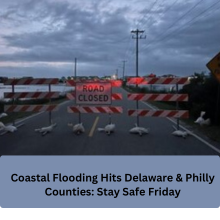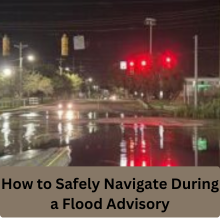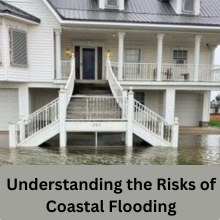
A coastal flood advisory has been issued for Delaware and Philadelphia counties, warning residents of potential flooding on Friday between 11 a.m. and 4 p.m. The National Weather Service has indicated that up to one foot of flooding could occur in low-lying areas near shorelines and tidal waterways, with some road closures possible. In this article, we’ll break down what this advisory means for you and how to stay safe in the event of coastal flooding.
Understanding Coastal Flooding
Coastal flooding occurs when high tides, heavy rainfall, or strong winds combine to overwhelm the capacity of shorelines and tidal waterways. This can lead to water inundation in low-lying areas, causing property damage and disruptions to daily life. In Delaware and Philadelphia counties, the risk of coastal flooding is particularly high because of their proximity to tidal waterways and low-lying terrain. As sea levels rise and weather patterns change, these areas are becoming more vulnerable to flooding events.
Details of the Coastal Flood Advisory
The coastal flood advisory issued for Friday affects Delaware and Philadelphia counties between 11 a.m. and 4 p.m. According to the National Weather Service, up to one foot of flooding could occur in areas near the shorelines and tidal waterways. This could lead to disruptions in traffic, with some roads becoming impassable. The advisory serves as a precautionary measure to alert residents about the risks of flooding and to encourage them to take protective actions.
What to Expect During the Advisory
During a coastal flood advisory, residents in the affected areas can expect localized flooding, especially near shorelines and tidal waterways. This type of flooding may begin to affect vulnerable roads, which could lead to road closures or detours. You may also notice increased water levels along the coast, which could make some routes unsafe for travel.
Flooding at this level typically does not result in widespread emergency evacuations but may cause significant inconvenience for those living or traveling in flood-prone areas.
How to Safely Navigate During a Flood Advisory
If you need to travel during a coastal flood advisory, safety should be your top priority. Here are some key tips:
- Avoid flooded roads – Don’t attempt to drive through standing water, especially if you can’t see the depth. Flooded roads are dangerous, and even shallow water can carry away a vehicle.
- Check for road closures – If you’re planning to travel, check local news or authorities for updates on road conditions. Allow extra time for detours if roads are closed.
- Never drive around barricades – Barricades are set up for your safety. Ignoring them could put you at risk of driving into dangerous floodwaters.
What Is a Coastal Flood Advisory?
A coastal flood advisory is a weather alert issued by the National Weather Service when moderate flooding is expected in coastal or tidal areas. It’s not as severe as a flood warning, but it still requires attention. The advisory is intended to inform residents of possible flooding and to encourage them to take preventive measures, such as securing property or avoiding flooded areas.
Unlike a flood warning, a coastal flood advisory does not mean that widespread damage will occur, but rather indicates that conditions are favorable for local flooding.
Weather Alerts: What They Really Mean
Understanding the difference between weather alerts can be confusing. Here is a description of the most common types:
Flash Flood Warning – Issued when a flash flood is imminent or already occurring. Immediate action is needed. Flash floods can happen quickly and without warning.
Flood Warning – Issued when flooding is already happening or will happen soon. Take protective action immediately.
Flood Advisory – Issued when minor flooding is expected. It may cause inconvenience but doesn’t necessarily pose a serious threat to life or property.
Flood Watch – Issued when conditions are favorable for flooding. Be prepared, but take no action yet.
Understanding the Risks of Coastal Flooding
Coastal flooding can be particularly dangerous due to the unique risks it poses:
- Property damage – Coastal flooding can damage homes, buildings, and infrastructure. Flood-prone areas are at risk of water entering properties and causing long-term damage.
- Road closures – Flooded roads can isolate neighborhoods, making travel difficult or impossible.
- Safety hazards – Even shallow floodwaters can cause disruptions. Swiftly moving water can carry debris, posing a threat to anyone caught in it.
How to protect your property from coastal flooding
If you live in a flood-prone area, it’s important to be prepared. Here are steps you can take to protect your property:
- Elevate valuables – Move furniture, electronics, and valuables to higher ground, away from areas likely to flood.
- Install flood barriers – Sandbags or flood barriers can prevent water from entering your home.
- Secure your home – Ensure that windows, doors, and basements are secure. If you have an elevated home, make sure that the foundation is properly sealed.
- Check drainage systems – Make sure gutters and drains are clear to allow water to flow away from your home.
Also read: Where to Stream Saturday Night and Get a Free Preview
Evacuation Plans: Why and How to Follow Them
In extreme flood situations, evacuation may be necessary. Here’s why you should always follow evacuation orders:
- Evacuations save lives – If authorities order an evacuation, it’s because floodwaters are posing a serious threat. Ignoring these orders puts you and your family in danger.
- Prepare an emergency kit – Have essentials like water, food, medications, and important documents ready to go if you need to evacuate.
- Follow official routes – Stick to evacuation routes recommended by local authorities and avoid driving through floodwaters.
Flood Safety Guidelines: Expert Advice
Flooding can be life-threatening, so it’s crucial to follow safety guidelines from the National Weather Service:
- Stay away from floodwaters – Even just six inches of moving water can knock you off your feet.
- Avoid electrical hazards – Don’t touch electrical outlets or devices if they’ve been exposed to water.
- Seek higher ground – If flooding threatens your area, move to higher ground immediately.
Flash Floods: The Hidden Danger
Flash floods are sudden and intense. They can occur within minutes of heavy rain or when a dam or levee fails. Flash floods are often more dangerous than coastal floods because they develop so quickly. If you live in an area prone to flash floods, stay alert and ready to evacuate at a moment’s notice.
The Role of Local Authorities During Flooding
Local authorities play a critical role in managing flood conditions. During a flood advisory, they may issue road closures, evacuations, and emergency alerts. They also coordinate rescue efforts and assist residents who need help. It’s important to listen to local authorities and follow their instructions to stay safe.
How to Stay Informed During the Advisory
To stay informed about the coastal flood advisory, consider the following:
- Sign up for weather alerts – Local authorities and the National Weather Service provide real-time updates.
- Monitor social media – Many local agencies post updates on their social media accounts.
- Listen to weather broadcasts – Radio stations often provide emergency information during severe weather events.
Conclusion
Coastal flooding poses a serious threat, but by understanding the risks and taking action, you can protect yourself and your property. Pay attention to weather advisories, follow safety guidelines, and stay informed to navigate these events as safely as possible.
FAQs
-
What does a coastal flood advisory mean for me?
- A coastal flood advisory means that localized flooding is expected, but it’s not as severe as a flood warning. Stay alert and take steps to protect your property.
-
How can I prepare my home for a flood?
- Move valuables to higher ground, install flood barriers, and ensure proper drainage systems.
-
Is it safe to drive during a flood advisory?
- No, you should avoid driving through flooded roads. Even shallow water can be dangerous.
-
What should I do if I’m caught in floodwaters?
- Move to higher ground immediately, avoid contact with electrical devices, and call 911 for help.
-
How can I stay informed about future flood advisories?
- Sign up for weather alerts, follow local authorities on social media, and listen to radio broadcasts for updates.

